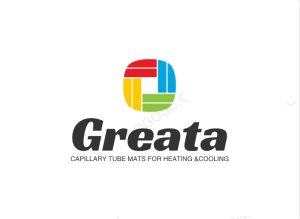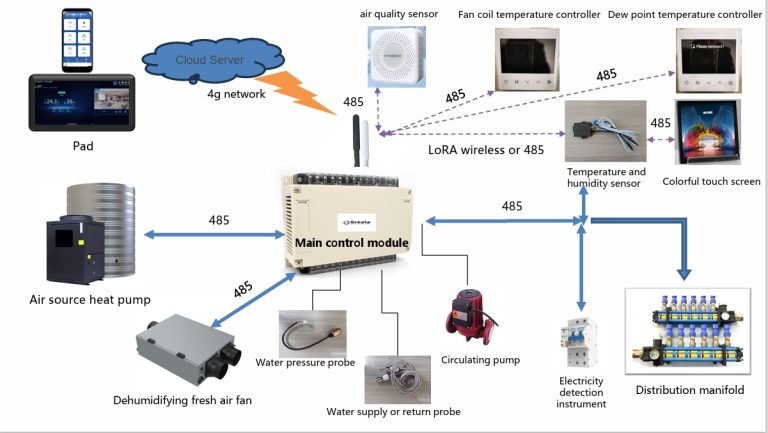Capillary tube mats are a type of radiant heating and cooling system that consists of a network of small-diameter capillary tubes embedded in a building structure, such as in floors, walls, or ceilings. These mats are designed to efficiently distribute heated or cooled water to provide comfortable indoor temperatures. When it comes to achieving best heating and cooling performance, capillary tube mats offer several advantages:
1. Uniform Temperature Distribution: Capillary tube mats provide a uniform distribution of heat or coolness across the surface area where they are installed. This ensures that the entire space experiences consistent temperatures, eliminating hot or cold spots.
2. Energy Efficiency: The small diameter of the capillary tubes allows for precise control over the flow of water, which contributes to energy efficiency. By circulating water at lower temperatures than traditional heating systems, capillary tube mats can reduce energy consumption and operating costs.
3. Fast Response Time: Due to their low thermal mass, capillary tube mats can respond quickly to changes in heating or cooling demand. This rapid response time enables the system to maintain a comfortable indoor environment with minimal fluctuations in temperature.
4. Comfort and Well-being: The radiant nature of capillary tube mats provides a high level of comfort, as they create a gentle, even warmth or cooling effect without the need for forced air circulation. This can contribute to improved indoor air quality and occupant well-being.
5. Integration with Renewable Energy Sources: Capillary tube mats are well-suited for integration with renewable energy sources, such as solar thermal systems or heat pumps. This allows for sustainable heating and cooling solutions that align with environmental goals.
6. Flexibility in Design: Capillary tube mats can be installed in various building structures, including new constructions and retrofit projects. Their flexibility in design and installation makes them suitable for a wide range of applications, from residential homes to commercial buildings.
7. Low Maintenance Requirements: Once installed, capillary tube mats generally have low maintenance requirements, as they have fewer moving parts compared to traditional HVAC systems. This can result in long-term cost savings and reduced downtime.
To optimize the performance of capillary tube mats, factors such as proper system design, hydraulic balancing, water quality, and control strategies should be carefully considered. Additionally, regular maintenance and monitoring are essential to ensure the long-term efficiency and reliability of the system
Capillary tube mats are heating and cooling devices that use capillary tubes to distribute a heat transfer medium, such as water or refrigerant, throughout the mat. These mats are typically used in floor heating systems, radiant heating systems, or cooling systems to provide even and efficient heat transfer.
The capillary tubes in the mat are small, thin tubes that are capable of transferring heat efficiently. The heat transfer medium flows through the tubes, absorbing heat from one area and releasing it in another. This process allows the mat to heat or cool a space evenly and quickly.
Capillary tube mats offer several advantages over traditional heating and cooling systems. They can provide more even heat distribution, which can be beneficial in areas with significant temperature differences between different parts of the room. Additionally, capillary tube mats are often more energy-efficient than traditional systems, as they can transfer heat more efficiently and require less energy to operate.
However, capillary tube mats may not be suitable for all applications. They may require a higher initial investment and may require specialized installation and maintenance. Additionally, they may not be able to provide the same level of heating or cooling as larger, more powerful systems.
If you are considering using capillary tube mats for your heating or cooling needs, it is important to consult with a professional to determine if they are the right choice for your specific application. They can help you understand the advantages and disadvantages of capillary tube mats and provide guidance on installation and maintenance.
The Advantages of the capillary mat System in short:
- deployable in both old and new buildings
- no irritation caused by either dry or polluted or heavily circulating air (draft) (comfortable feeling)
- constantly relative air humidity between 40% and 60% protects furniture (antiques)
- prevention of mold fungus because of high ph-factor of calcium-silicate
- avoidance of condensate problems when in the cooling process the dew point is being undercut (no dew point sensor required)
- storage of occurring condensate in calcium-silicate panel
- passive cooling when the system is deactivated and the condensate humidity is slowly returning into the room ( by way of evaporation)
- avoidance of condensate problems when in case of cold outside temperature humid and cold air from outside meets onto up-heated room air
- applicable for use in moderate as well as subtropical climate
- perfect combination of inside insulating plaster and Hippokrates-System
- maintenance free – no changing of filters or checking of burners
- easy to handle because of a simple control technology
- long service life
- environmental protection
- cooling and heating in one system
- comfortable room climate because of radiation energy
- applicable at walls, ceilings and floor
- strict CO₂-neutrality reachable
- substantial reduction of energy costs up to 90% because of consequent usage of regenerative energy sources due to low inlet temperature
- considerable reduction of insulation costs since no outside insulation required, especially for (monument-listed) buildings
- insulation on the inside of monument-listed buildings without disturbing – or even worse – destroying the appearance of the historical façade
- no inflammability of the insulation material (neither the permeable inside insulating plaster nor calcium-silicate is inflammable but extremely heat-resisting)





